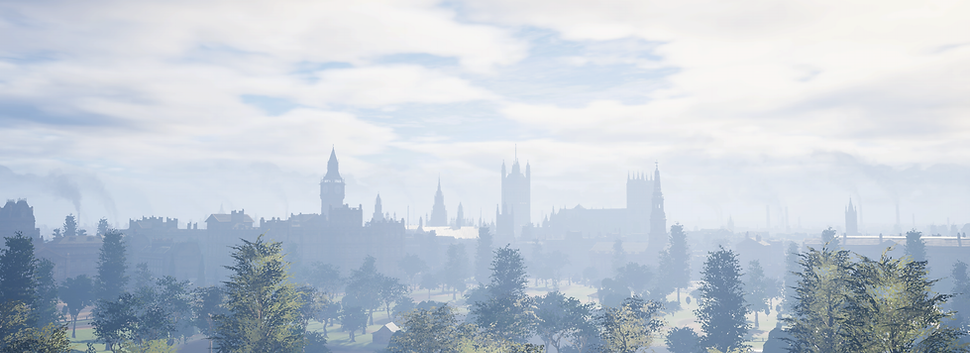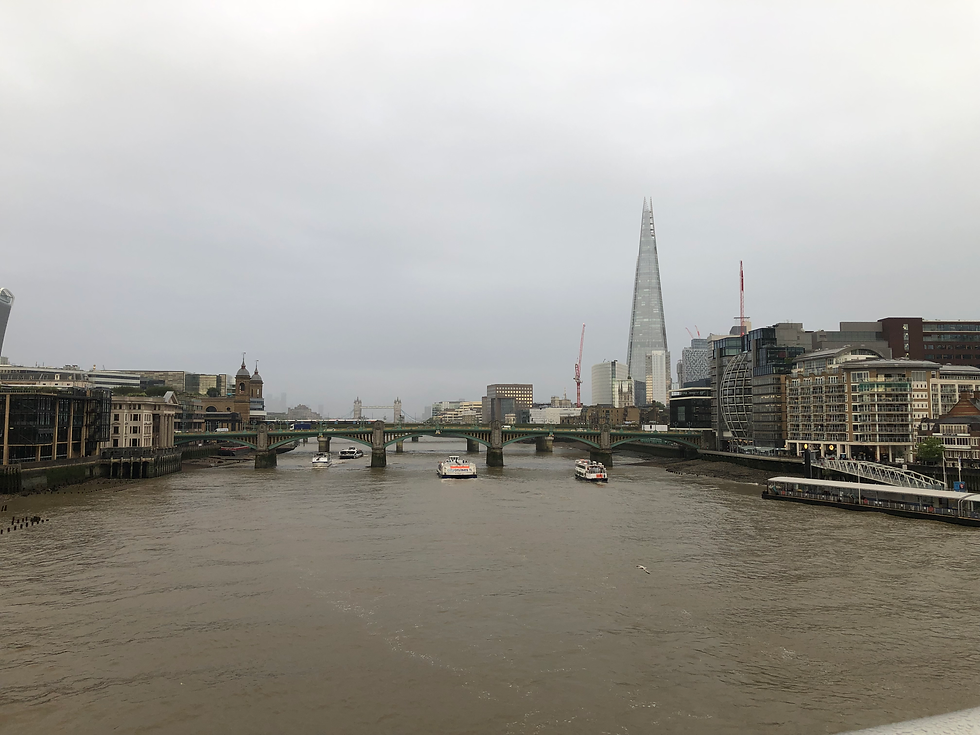
Searching For The Creed - London II
Breakdown
Gustav / Gargudon from our team has called the great English capital a second home last three years’ time now, doing a lot of back and forth between there and native Denmark every now and then. This we saw as an occasion for our very first Searching For The Creed article a while ago, comparing landmarks found throughout the city, to their portrayal in Assassin’s Creed Syndicate. That article contained but a fraction of them though, and now with Syndicate’s 10th anniversary right around the corner as well, we shift focus towards some of the rest!
Temple Church
Kicking off the list, we take a look at Temple Church, which served as the headquarters of the real Knights Templar in England during Medieval times. The main round part of the church is based on The Church Of The Holy Sepulchre in Jerusalem - the burial site of Jesus Christ - to recreate the sanctity of the Holy Sepulchre and feeling of being there. The round church was used from 1163, the Templars moving there from their original English house located in Holborn, having been used since the 1140s.
Not much to say about it other than Ubisoft Quebec did a great job doing so. While the church’s interior is inaccessible in-game and was not recreated, the visible exterior of it more or less looks identical to its real life counterpart.
Temple Church is open and can be visited Monday-Friday from 10:00-16:00, with admission ranging from 3-5£, with children being admitted free of charge.


Tower Bridge
Located on the edge of the borough of Tower Hamlets bordering City Of London, Tower Bridge is undoubtedly one of the great city’s most famous and iconic landmarks, attracting thousands and thousands of visitors every year. Construction of the bridge began in 1886, and stood finished and opened 8 years later in 1894. The bridge is particularly famous for its two bascules that can be lifted, allowing for smaller ships to pass through.
Found during the World War I segment of the game, the recreation of the bridge is more or less spot on, only major difference between then and now, being the construction of the glass floor walkway located at the top of the bridge, that only opened as recently as 2014.
The bridge itself is open and free to walk across 24/7, and interior admittance is from 09:30-18:00 every day of the week, with tickets granting access to the engine rooms and glass walkways priced at 6,70£ for children and 13,40£ for adults.


Tower of London
Also located on the very edge of Tower Hamlets right next to Tower Bridge, is of course the Tower of London, another one of the city’s most iconic landmarks. Construction first began in 1066, William The Conqueror erecting the first fortifications. The central “White Tower” was started a few years later around 1078, and fortifications were extended in the 12th and 13th centuries. The Tower has served as everything from Royal palace and residence, a public records office, an arsenal and more, but probably most notably a prison and execution ground, also housing the (in)famous Traitor’s Gate on the river.
Also found during select memories and the World War I segment of the game, honestly not much to say, other than Ubisoft Quebec more or less perfectly recreated the iconic landmark, both the fortified exterior, the courtyard, as well as interior with armours, weaponry and more on display.
Tower of London is open and can be visited from 9/10:00-16:30 from October to March, and until 17:30 from April to September, every day of the week year round, with the exception of January 1st, 6th and 7th, as well as December 24-26th. Tickets start at 17,90£ for children, and are up to 35,80£ for adults.


King’s Cross St. Pancras
Located in the southern end of the borough of Camden, King’s Cross St. Pancras is one of London’s biggest and most famous train stations. Originally opened in 1868, it shares a building with the former Midland Grand Hotel, and is considered one of the greatest marvels of Victorian Gothic architecture. Since its opening 157 years ago, it has been expanded more than once, and from 2007 and onwards, the station has been widely known for its Eurostar services to Paris, Brussels, Amsterdam and more of mainland Europe.
There are a few notable differences between the real station and its in-game portrayal, parts of the facade looking slightly different in-game, as well as the lack of the building’s main tall tower, but ultimately the game’s portrayal still captures the look, colours and essence of it.


Charing Cross
Located right besides the iconic Trafalgar Square in the very heart of Central London, Charing Cross is another one of the great city’s biggest and busiest train stations. The station originally opened in 1864, South Eastern Railway looking to expand their line across The Thames from London Bridge into the West End and other parts of Central, given growing demand from commuters.
Not much to say about it other than Ubisoft Quebec did a great job recreating the station building’s iconic facade, a few minor changes naturally having come with the years. The station’s interior has also changed, today having a sleeker, more modern look instead of classic Victorian architecture.
Even today the station remains widely used for its South Eastern Railway services to a number of destinations across Kent and East Sussex in Southeast England, as well as its Underground services, with an approximate 37 million passengers passing through the station every year.


Victoria Station
Located in the heart of the borough of Westminster, Victoria Station is one of the city’s most popular and largest train stations. Competing for services going to the West End, two railway companies - London Brighton & South Coast and London Chatham & Dover - started building each their side of the station, with the former’s side opening in 1860, and the latter’s two years later in 1862.
There are a few notable differences, but also similarities between the game’s portrayal and the real building. The station’s iconic facade has more or less always looked the same, but the interior is significantly smaller in-game and looks quite different. This ultimately makes sense, with how the station underwent big rebuilding, re-opening in 1909. Overall though, Ubisoft Quebec did a great job recreating the landmark, from the the iconic facade to the general feel of the station.
The station has only evolved further with the years, seeing the removal of old walls dividing the two railway companies’ sides of it, and in the 1980’s, Victoria Plaza came to be, housing offices, as well as a minor shopping complex. Today the station is widely known for its services to a number of destinations in South England - from Brighton, Southampton, Portsmouth and more - and is also widely used for its fast and cheap services to London Gatwick Airport by thousands of visitors every year.


Monument
Located at the beginning of the City Of London to the East, The Monument to the Great Fire Of London stands tall just off of Fish St Hill and Monument St. Designed by architects Christopher Wren and Robert Hooke, construction of the spire began in 1671, and stood finished 6 years later in 1677, commemorating the great fire in September of 1666, destroying over 13.000 houses, 87 churches and many more buildings. The Monument also stands close to Pudding Lane where the fire started, in a small bakery owned by Thomas Farriner.
There are a few notable differences between the game’s portrayal and its real life counterpart. The spire itself looks pretty accurate and spot on - although we are unaware of any secret ancient civilisation technology hidden inside it - and its more the surrounding area that has changed drastically, then being in a much wider and more open space, today being closely surrounded by modern buildings.
The Monument is open and can be visited - walking to the top of it offering stunning views of Central London - from 9:30-18:00 every day of the week, closed for lunch from 13:00-14:00, and with the exception of 24th-26th December. Tickets are 3£ for 5+ children (under go free) and 6£ for adults, with special reduced prices for students and disabled.



London Bridge
And concluding this list is one of the city’s most legendary bridges, simply named after the city, as well as most iconic and enduring landmarks. Located on the River Thames between Southwark and the City Of London, it is one to have undergone the most changes since its inception almost 1000 years ago.
Construction originally began in 1176 under Peter of Colechurch, replacing a timber bridge built in late Roman and early Medieval times. He passed away in 1205, but his vision was completed by fellow citizens 4 years later in 1209. The original Medieval London Bridge, remains one of the greatest marvels of Medieval architecture, housing numerous stores by the waysides, houses built above them, with up to 138 premises recorded by 1358. The bridge fascinatingly also remained the only connection point between the North and South side of The Thames, until the construction of Westminster Bridge in 1750. After years of frequent repairs, a major renovation project came underway, all houses were removed by 1762, and the ultimately simpler bridge, only housing walkways and traffic lanes as we know it today was slowly born.
Honestly not much to say about the bridge, other than Quebec did a great job recreating it, and it more or less looked the same mid-19th century as it does today. The vicinity around has certainly changed and evolved though, today famously housing everything from Borough Market famous for its restaurants and street food, the iconic The Shard, and of course London Bridge station, widely used for its Underground, as well as services to South- & Southeast England, including Brighton, Gatwick Airport, a number of destinations across Kent & East Sussex and more.


And that concludes this second list of landmarks found throughout London, compared to their portrayal in AC Syndicate, and now we have just about taken a look at every major noteworthy landmark in the city. Make sure to stay tuned for more Searching For The Creed articles in the future, as we shift focus towards other locations from throughout the games. Be sure to also check out our other existing comparison articles, taking a look at other places in London, Florence and Rome.
About the Author
Gustav / Gargudon is an active community member, who started out in podcast hosting in 2016, but today mostly specialises in video creation, interviews & composing. By joining The Ones Who Came Before in 2019, originally reviving 'The Memory Corridor' podcast, which had been offline for nearly a year, he has had the opportunity to expand his audience and further develop his skills.
His unique skill set made him the perfect candidate for our team. Among other things, he is known in the community for the Sounds Of History project - an original Assassin’s Creed inspired instrumental music project, featuring five tracks inspired by as many different games - other original fan themes plus covers of iconic AC tracks, as well as video interviews with a number of high profile names in the world of AC, from Roger Craig Smith, Jesper Kyd and more.
Fun fact, among his growing colourful tattoo collection, Gustav is the only member of our team to have the TOWCB logo inked.
Gustav Poulsen (Gargudon)

